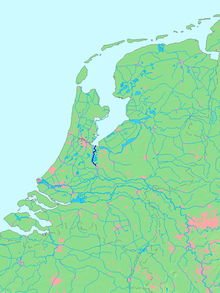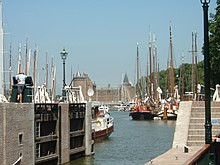Utrechtsche Vecht
The Utrechtsche Vecht is a 40 km long river in the Netherlands . It flows from the city of Utrecht via Maarssen , Breukelen and Weesp to Muiden , where it flows into the Gooimeer , a marginal lake of the IJsselmeer .
The largely canalized, but still winding and picturesque river is used exclusively for water sports. The former transport function of the Vecht was taken over by the Amsterdam-Rhine Canal , as the curves and drawbridges hindered shipping. The five locks between the Vecht and the Canal have been open since 1983, so the water level in both bodies of water has been the same since then.
history
In Roman times the river was known under the name Fectio. Fort Fectio was at the junction from the Old Rhine.
In the Middle Ages, the Vecht was an important shipping link between the Zuidersee , from where there was a connection to Northern Europe, and the Rhine, via which one could reach today's Germany. Because of its strategic importance, several forts were built along the Vecht . They include Nijenrode and Muiderslot . The river was part of the Dutch waterline .
From the 17th century onwards, many wealthy Amsterdam merchants built their manors and castles along the Vecht. They are still an attraction today for the many water hikers on the Vecht.
Direction of flow
The Vecht is one of the few rivers in which the water sometimes flows to the source. This is the case when the water level of the IJsselmeer is higher than the water level of the Vecht at the Muiden lock. The Vecht only flows towards the estuary when it rains heavily. At Nigtevecht there is a connection to the Amsterdam-Rhine Canal.
Web links
- Vecht Wiki (Dutch)


